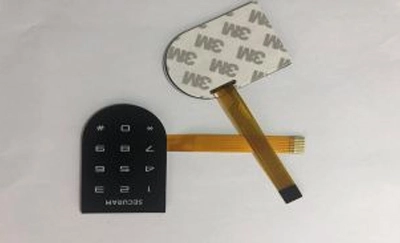
There may be different design schemes for the same product in the electronics industry. Membrane switches in industrial products can be divided into Tactile and Non-Tactile. Which ones can be used as Tactile membrane switch or Non-Tactile membrane switch.
Then we need to understand difference between TACTILE VS. NON-TACTILE MEMBRANE SWITCHES more deeply:
Tactile membrane switch can also be called momentary membrane switch. Tactile means has feedback. When the operator presses the switch button, the operator can clearly feel the tactile sensation given by the button and the sound from the button. This is due to the deformation of the Dome. If the pressure is removed and Dome returns to its original state, the circuit connection is interrupted.
There are several factors that affect the Tactile membrane switch:
1. The thickness of the panel material: The thickness of the panel material of different thickness will have different effects on the feel of the product. Generally, the thicker the material, the worse the hand feel. Conversely, the thinner the material, the better the hand feel.
2. Whether the product has Embossing, Embossing height, shape, etc. Generally, embossing height of 0.3-0.5mm is the most commonly used, and the tactile feel is relatively good.
3. The force of the metal dome is an important factor that affects the membrane switch panel. The metal dome is generally placed between the graphics overlay and the bottom line. At the same time, there is a fixed layer above the metal dome to fix the metal dome to prevent the metal dome from moving. When the user hears the sound, it means that the button has been driven and the function has been implemented. The life of metal dome is generally 1,000,000 times and even part of the metal dome can reach more than 5,000,000 times without damage. Sometimes the thickness of the pattern covering layer to the circuit level of the membrane switch is too thick, we need to increase the tactile dot to increase the touch, and even punch holes above the fixed layer, add air grooves and other forms to meet customer needs.
4. The choice of mold, in the touch keypad membrane switch, there is often a small detail that is ignored by everyone, that is, the mold will actually affect the feel of the product. Generally speaking, the membrane switch produced by Stainless tooling is better than the CNC tooling membrane switch. Feel better. And this involves another type of membrane switch-Poly dome membrane switch.
An important difference between Non-Tactile membrane switch and Tactile membrane switch is that there is no mechanical movement-when the buttons are pressed, there is no feedback response. At the same time, Non-Tactile Membrane switches are basically flat surfaces without protrusions, but they also have embossed outer edges. Non-Tactile membrane switch allows the operator to quickly locate the button. The product has no tactile feel and no metal dome, but it has obvious cost advantages and is easier to clean. Unlike the tactile feedback of Tactile Membrane Switch, Non-Tactile Membrane Switch feedback reflects whether the button is activated or not through the color change of LEDs and the change of LCD screen content.
In any case, these two forms of membrane switch still have obvious advantages compared with traditional mechanical switches:
1. The product is thinner and smaller
2. More convenient to clean up
3. Heat-resistant, waterproof, chemical-resistant and UV-resistant (through material selection)
The buttons of the silicone rubber keypad are basically high-touch products. Through the change of web, different loads are formed. Spray PU or hand-feel oil protection patterns on the surface of the keys or perform laser engraving process. There are two types of conduction: 1. The carbon pellet at the bottom of the Silicone rubber keypad contacts the PCB circuit to form conduction. 2. By using the button as a conductor, squeeze the metal dome above the PCB to form a conduction between the PCB and the shrapnel.
If you have any more questions about how Tactile and Non-Tactile products work contact us today! Niceone-tech specializes in making custom, high-quality products made specifically to any business needs!